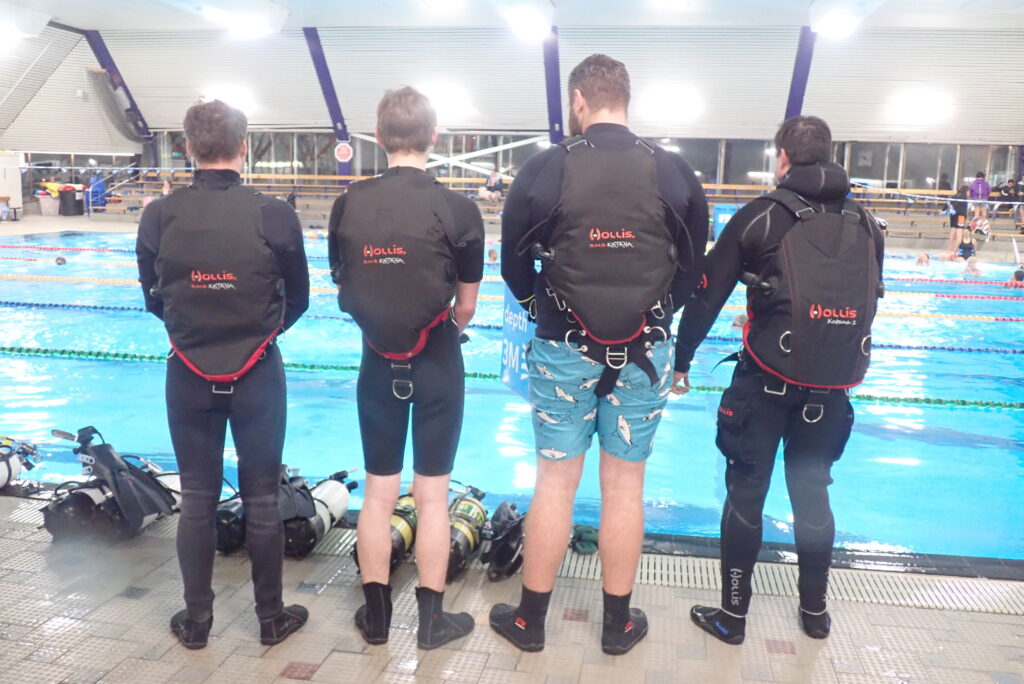Ever wanted to double your bottom time? Increase your safety underwater? Look super cool? If so,
sidemount diving might be just what you’re after. Sidemount diving, a diving technique where a
diver carries their tanks on their sides rather than on their back, offers a unique experience and way
of diving.

What is Sidemount Diving?
Sidemount diving originated as a cave diving technique, allowing divers to navigate through tight
spaces where traditional back-mounted tanks would be cumbersome. However, its popularity has
spread beyond cave diving to recreational and technical diving alike. In sidemount diving, tanks are
attached to the sides of the diver’s harness, providing greater flexibility and streamlining underwater
movement.
Benefits of Sidemount
One of the most appealing aspects of sidemount diving is the freedom of movement it offers. With
tanks positioned along the sides of the body, divers experience less strain on their backs and a more
balanced distribution of weight. This allows for easier maneuverability while in the water. The extra
tank offers gas redundancy for your dive. If one tank or reg were to fail, you can shut said tank off,
switch to your other, and safely end the dive.
Sidemount diving also offers enhanced buoyancy control compared to traditional back-mounted
diving configurations. By having separate tanks on each side, divers can adjust their buoyancy more
precisely, achieving a perfect trim and maintaining stability throughout the dive. This level of control
not only enhances safety but also allows divers to conserve energy and focus on enjoying their
underwater surroundings.
One of the great things about sidemount diving is its accessibility to divers of all levels. Whether
you’re a beginner looking to expand your diving skills or an experienced diver seeking a new
challenge, sidemount diving offers something for everyone.
Furthermore, sidemount diving can be adapted to suit a variety of diving scenarios. From
recreational dives on coral reefs to technical dives on deep wrecks, the versatility of sidemount
diving makes it a valuable skill for any diver’s set.

My experience with Sidemount
In July of 2023 I completed my sidemount training. The opportunity presented itself, and even
though it was the middle of winter, I took it up. It kind of felt like going back to open water, with
everything so unfamiliar and the 150+ previous dives I had done seemingly not serving me in the
slightest, but that was a really good feeling. It made me invested in the course, and made it feel all
the more amazing when I finally felt as if I was getting the hang of it. The most interesting thing that
I learnt is about how the different pressures in each cylinder effect your buoyancy, and how you
should do a gas switch (going to the other bottle) roughly every thirty bar, so you don’t end up listing
to one side. The reason for the 2m reg hose on the right post was also very interesting. It’s put
together that way so cave divers could share air in an enclosed environment, with one out in front leading the way and one behind breathing off the longer hose. By far, the most fun skill would have
to be unclipping both the tanks and “superman” holding them out in front of me to decrease my
horizontal profile. I never thought I’d be able to make it through that hoop, but by the end of the
training dives I could with ease. I thoroughly enjoyed freezing at the bottom of the harbour in order
to learn this new skill and would do it again in a heartbeat.
Conclusion
In conclusion, sidemount diving opens up a world of possibilities for underwater exploration. With
its emphasis on freedom of movement, enhanced buoyancy control, and adaptability to various
diving environments, sidemount diving offers a unique and exhilarating experience for divers of all
levels.


Ngā mihi nui,
Max Te Moananui
PADI Master Scuba Diver trainer
